Related Research Articles
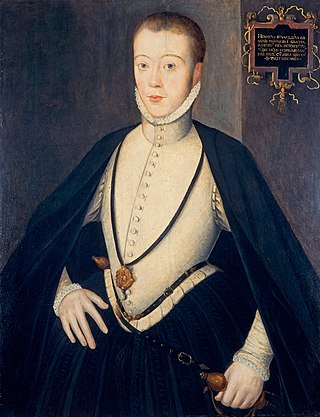
Henry Stuart, Lord Darnley was King of Scotland as the second husband of Mary, Queen of Scots, from 29 July 1565 until his murder in 1567. Lord Darnley had one child with Mary, the future James VI of Scotland and I of England. Through his parents, he had claims to both the Scottish and English thrones. Less than a year after the birth of his son, Darnley was murdered at Kirk o' Field in 1567. Many contemporary narratives describing his life and death refer to him as simply Lord Darnley, his title as heir apparent to the Earldom of Lennox.

Elizabeth Cavendish, later Elizabeth Talbot, Countess of Shrewsbury, known as Bess of Hardwick, of Hardwick Hall, Derbyshire, was a notable figure of Elizabethan English society. By a series of well-made marriages, she rose to the highest levels of English nobility and became enormously wealthy. Bess was reportedly a shrewd businesswoman, increasing her assets with business interests including mines and glass-making workshops.

Lady Arbella Stuart was an English noblewoman who was considered a possible successor to Queen Elizabeth I of England. During the reign of King James VI and I, she married William Seymour, 2nd Duke of Somerset, another claimant to the English throne, in secret. King James imprisoned William Seymour and placed her under house arrest. When she and her husband tried to escape England, she was captured and imprisoned in the Tower of London, where she died at age 39.
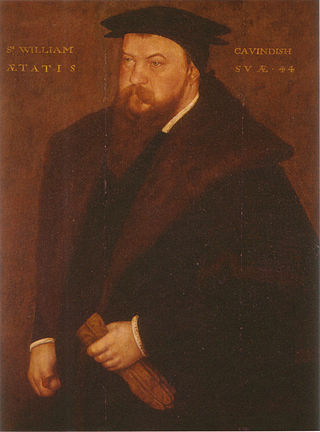
Sir William Cavendish MP was an English politician, knight and courtier. Cavendish held public office and accumulated a considerable fortune, and became one of Thomas Cromwell's "visitors of the monasteries" during the dissolution of the monasteries. He was MP for Thirsk in 1547. In 1547 he married Bess of Hardwick, and the couple began the construction of Chatsworth House in 1552, a project which would not be completed until after his death. His second son William Cavendish (1552–1626) became the first Earl of Devonshire, purchasing his title from the impecunious King James I.
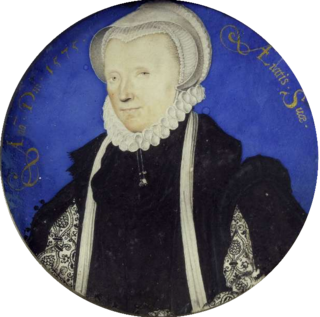
Margaret Douglas, Countess of Lennox, was the daughter of the Scottish queen dowager Margaret Tudor and her second husband Archibald Douglas, 6th Earl of Angus, and thus the granddaughter of King Henry VII of England and the half-sister of King James V. She was the grandmother of King James VI and I.

Sheffield Manor Lodge, also known as Sheffield Manor or locally as Manor Castle, is a lodge built about 1516 in what then was a large deer park southeast of Sheffield, South Yorkshire, England, to provide a country retreat and further accommodate George Talbot, the 4th Earl of Shrewsbury, and his large family. The remnant of this estate is now known as Norfolk Park. The housing estate of Manor is named after Sheffield Manor Lodge.
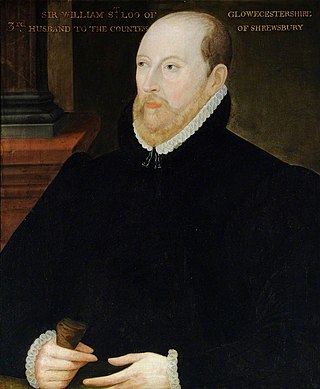
Matthew Stewart, 4th Earl of Lennox was a leader of the Catholic nobility in Scotland. He was the paternal grandfather of King James VI of Scotland. He owned Temple Newsam in Yorkshire, England.

George Talbot, 6th Earl of Shrewsbury, 6th Earl of Waterford, 12th Baron Talbot, KG, Earl Marshal (c. 1522/1528 – 18 November 1590) was an English magnate and military commander. He also held the subsidiary titles of 15th Baron Strange of Blackmere and 11th Baron Furnivall. He was best known for his tenure as keeper of Mary, Queen of Scots between 1568 and 1585, his marriage to his second wife Elizabeth Talbot, as well as his surviving collection of written work.
Charles Stuart, 5th Earl of Lennox, was the fourth son of Matthew Stewart, 4th Earl of Lennox and Lady Margaret Douglas, daughter of Margaret Tudor and granddaughter of King Henry VII of England. His brother was Henry Stuart, Lord Darnley, husband of Mary, Queen of Scots. He was the uncle of King James VI and I.

Gilbert Talbot, 7th Earl of Shrewsbury, 7th Earl of Waterford, 13th Baron Talbot, KG, styled Lord Talbot from 1582 to 1590, was a peer in the peerage of England. He also held the subsidiary titles of 16th Baron Strange of Blackmere and 12th Baron Furnivall.

Mary Talbot, Countess of Shrewsbury (1556–1632) was the wife of Gilbert Talbot, 7th Earl of Shrewsbury.
Stewart of Darnley, also known as the Lennox Stewarts, was a notable Scots family. They were a branch of the Clan Stewart, who provided the English Stuart monarchs with their male-line Stuart descent, after the reunion of their branch with the royal Scottish branch.

The Other Queen is a 2008 historical novel by British author Philippa Gregory which chronicles the long imprisonment in England of Mary, Queen of Scots. The story is told from three points of view: Mary Stuart, Queen of Scots; Elizabeth Talbot, Countess of Shrewsbury, also known as Bess of Hardwick; and George Talbot, the 6th Earl of Shrewsbury.

Thomas Fowler was an English lawyer, diplomat, courtier, spy, servant of the Countess of Lennox, broker of the marriage of Mary, Queen of Scots and Lord Darnley, steward of the Earl of Leicester, advisor to James VI of Scotland and the Scottish ambassador in London, Archibald Douglas.
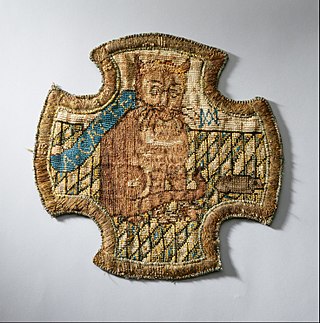
The Oxburgh Hangings are needlework bed hangings that are held in Oxburgh Hall in Norfolk, England, made by Mary, Queen of Scots and Bess of Hardwick, during the period of Mary's captivity in England.

Sir Henry Hardwick Cavendish (1550–1616) was the eldest son of the Tudor courtier Sir William Cavendish, and Lady Elizabeth Talbot, Countess of Shrewsbury, known as "Bess of Hardwick". A Knight of the Shire for Derbyshire, he offered military service to Queen Elizabeth in the Netherlands as a Captain in 1578; conducted several trade expeditions across Europe and into the Islamic Near East (Constantinople); served as High Sheriff of Derbyshire twice and was elected as Member of Parliament for Derbyshire five times.
Lady Gertrude Talbot, Countess of Shrewsbury, formerly Gertrude Manners, was an English noblewoman of the Elizabethan period.
John Elphinstone of Selmes and Baberton (1553-1614) was a Scottish landowner and courtier.

Sir Charles Cavendish was an English landowner. He was a son of Bess of Hardwick and William Cavendish (1505–1557).

Jewels belonging to Arbella Stuart were noted in several lists. They include jewels which she inherited from her grandmother, Margaret Douglas, Countess of Lennox, which were taken to Scotland by her mother's executor.
References
- ↑ Lovell 2005, p. 92
- ↑ Fraser 1971, pp.474-475
- ↑ Correspondence diplomatique de Bertrand de Salignac de la Mothe Fénélon, 6 (Paris, 1840), p. 319.
- ↑ Antonia Fraser, Mary, Queen of Scots, pp.534-535
- ↑ Fraser 1971, p. 535
- ↑ Henry Ellis, Original Letters Illustrative of English History, 2nd series vol. 3 (London, 1827), pp. 60-1.
- Antonia Fraser, Mary, Queen of Scots, Dell Publishing Co., Inc. New York, 1971
- David N. Durant, Arbella Stuart: A Rival to the Queen, Weidenfeld & Nicolson, 1978
- Mary S. Lovell, Bess of Hardwick, First Lady of Chatsworth, Little, Brown, 2005